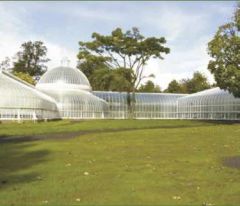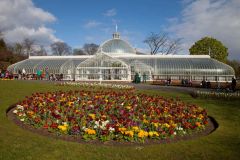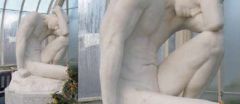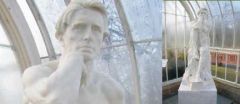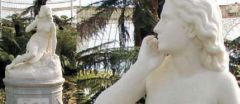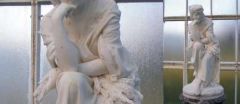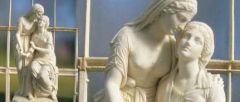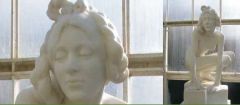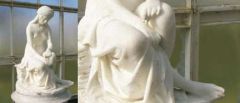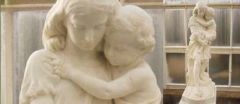Kibble Palace (1873)
This is an 'A' listed 19th century, curvilinear iron structure of exquisite design and form. Originally owned by John Kibble, an engineer with wide interests and some eccentricities, his private conservatory was moved to its present site in 1873. The main conservatory: 150ft (46m) in diameter, is spanned by a saucer-shaped dome with cupola.
The Kibble Place was closed in 2003 in advance of a multimillion pound restoration. This was completed in 2006 and the glasshouse re-opened to the public on St Andrews day that year.
Marble Statues in the Kibble
Cain (1899)
The sculpture of Cain, son of Adam and Eve crouching in anguish at his punishment for jealously murdering his brother Abel is the work of Edwin Roscoe Mullins (1848-1907)
King Robert of Sicily (c1927)
The seated statue of King Robert and his monkey, executed by the Scottish sculptor George Henry Paulin (1888-1962).
Eve (c1880)
This marble statue of Eve, the first woman was created by Italian sculptor Scipione Tadolini (1822-1892). This remarkable artwork is the centrepiece of the Kibble (Palace).
Ruth (c1880)
Ruth, traditionally said to be an ancestor of Christ, is sculpted by Milanese sculptor Giovanni Cinselli (1832-1883) who specialised in portraits of Biblical and mythological figures.
The sisters of Bethan (1871)
Nineteenth century English sculptor John Warrington Wood (1839-1886) captures Martha and Mary, sisters of Lazarus.
The Elf (1899)
Welsh sculptor William Gascombe John (1860-1952) regarded the 'Elf' as one of his greatest achievements. This stood in Kelvingrove Art Galleries from 1901 to the 1930s when it moved to its current setting.
Nubian Slave (after 1858)
The statue of an oriental slave was sculpted by Italian Antonio Rossetti (181 9-1891).
